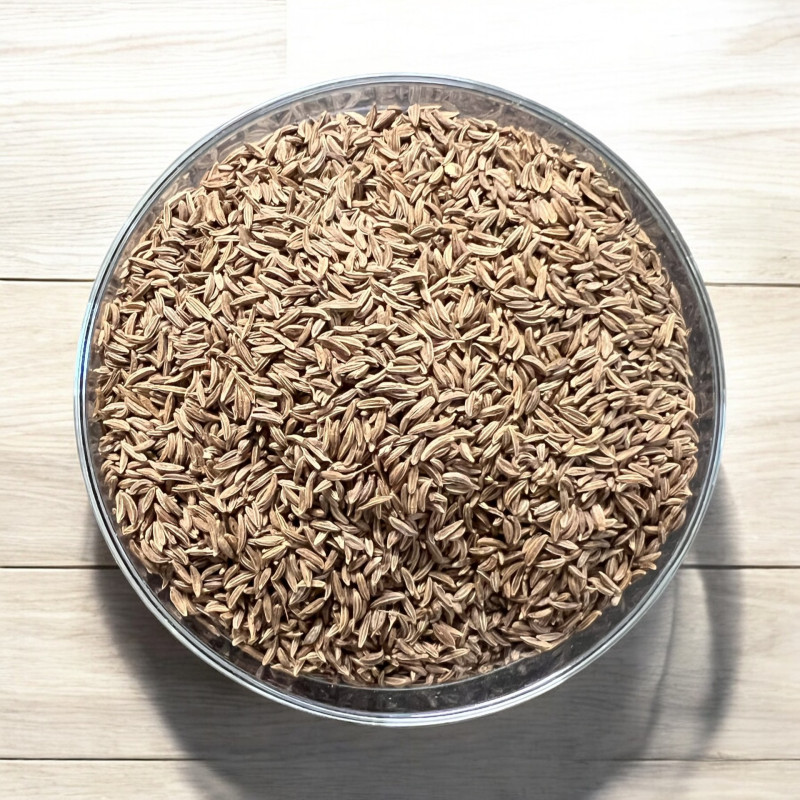- Reduced price



Its appearance resembles cumin, but its light, minty, and refreshing flavor is quite different.
Delicious with cheeses (especially Munster), in sauerkraut, and with vegetables. When ground, it’s often used in spice blends for couscous.
 Delivery
Delivery
Mondial Relay
 Returns
Returns
See conditions
 Payments
Payments
100% secure
Livré en sachet refermable
Culinary Uses:
Caraway has a slightly aniseed flavor with hints of lemon and mint, making it very refreshing.
It’s the seeds (whole or ground) that are primarily used in cooking, though the fresh leaves, much milder in aroma, are also sometimes consumed. Caraway is used to flavor meats (pork, game, goose), making them easier to digest.
It’s also widely enjoyed with strong cheeses like Munster or Maroilles. A few seeds with each bite of these cheeses can refresh their intense taste and aid digestion. Caraway is traditionally used in charcuterie, sausages, sauerkraut, goulash, Tunisian harissa, as well as in some savory pastries and breads.
Caraway seeds are also delicious with potatoes, cabbage, carrots, turnips, and mushrooms, enhancing their flavor while aiding digestion.
A staple in German, Eastern European, and Northern European cuisine, caraway is a key ingredient in Kummel, a traditional liqueur from these regions. It’s also found in other spirits like aquavit, gin, and schnapps.
Who Am I?
Origin: Egypt
Scientific Name: Carum carvi
Other Names: Meadow cumin, Vosges anise, Holland cumin, black cumin, false anise
Caraway is particularly known for its digestive benefits. To enjoy these benefits, add it to dishes, chew a few seeds after meals, or make an infusion by slightly crushing the seeds first. For this purpose, caraway pairs well with fennel, star anise, chamomile, and mint, which have similar properties. It’s even mild enough to be given to babies in a bottle infusion to relieve stomach pain.
Caraway seeds are rich in calcium, iron, and dietary fiber. They also contain two essential oils: carvone and limonene.
Caraway is a biennial herbaceous plant, 50 to 75 cm tall, in the Apiaceae (Umbelliferae) family, native to Central Europe and cultivated for its leaves but primarily for its aromatic seeds, which are used as a condiment and in medicine. It thrives in temperate to warm climates, found in Tunisia, Turkey, the Caucasus, Afghanistan, Iraq, China, and Europe. It even grows wild in France and Portugal.
The leaves are fine and linear. The small white flowers form terminal umbels. The seeds are gray-brown and slightly curved.
Caraway is closely related to fennel, cumin, green anise, and dill. It’s often mistaken for cumin, and many people refer to caraway as "cumin," adding to the confusion. The two seeds do look very similar.
Widely cultivated in temperate regions, caraway is sown in spring. The leaves are harvested after three months, and the seeds in the second year.
A Bit of History:
The name "Caraway" is derived from "karâwiyâ," an Arabic word meaning "sugar root," as caraway’s root was once consumed as well.
Caraway was used as early as 1500 BCE in ancient Egypt for its medicinal properties, and even Shakespeare mentions it in one of his plays!
Data sheet
 Anne Marie P.
Anne Marie P.
Plus subtil que. Le cumin
 Denis G.
Denis G.
Top (produit et emballage hermétique) !

 Anne Marie P.
Anne Marie P.
Plus subtil que. Le cumin
 Denis G.
Denis G.
Top (produit et emballage hermétique) !

Reference: EPI2301007
Reference: 20701706
Reference: 00033669-0001
Reference: coriandreE
Reference: grainesaroussir
Reference: 20701706
Reference: celerigraines
Reference: 11N7892701
Reference: 10M6741201
Reference: 9N76632004
Brand: Epiciane
Reference: 124510
Reference: fenouilE
Reference: 12N7949601
Reference: 11N7754201
Reference: 00033669-0001
Reference: 20711101
Reference: 2N7072401

Its appearance resembles cumin, but its light, minty, and refreshing flavor is quite different.
Delicious with cheeses (especially Munster), in sauerkraut, and with vegetables. When ground, it’s often used in spice blends for couscous.